Economics
The State Of India's States: Here Are The Prime Movers, The Steady Climbers, And The Economic Laggards
Venu Gopal Narayanan
Jan 15, 2025, 03:54 PM | Updated Jan 17, 2025, 03:10 PM IST
Save & read from anywhere!
Bookmark stories for easy access on any device or the Swarajya app.
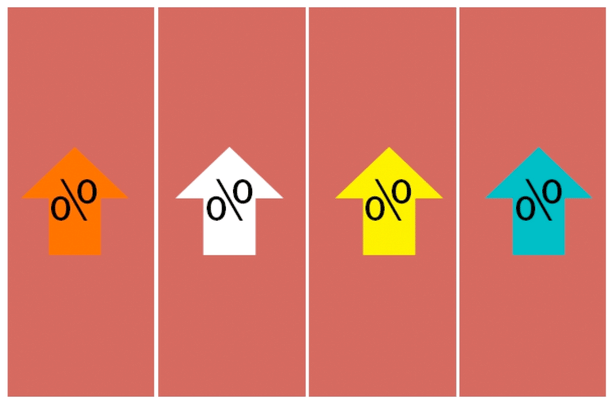
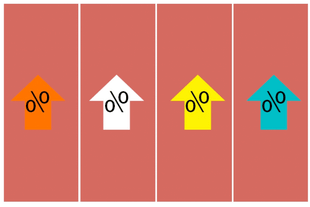
A new year and a new impending budget provide a good time to review the economic status of India's states, based on the Reserve Bank of India’s annual handbook of state-level economic data released a month ago.
The publication is chock-a-block with serious data and some eye-opening nuggets, and merits a dozen articles if justice is to be done to it. But for this piece, we shall take up a macro-level analysis of growth by state, and contribution by economic sectors, and draw inferences thereon.
The good news is that the five largest economies, which constitute half the economy, are all growing at a fair clip: Maharashtra, Gujarat, Tamil Nadu, Karnataka and Uttar Pradesh, in descending order. But the rest, barring Haryana and Delhi to some extent, are fluctuating between tepid growth and a near plateau.
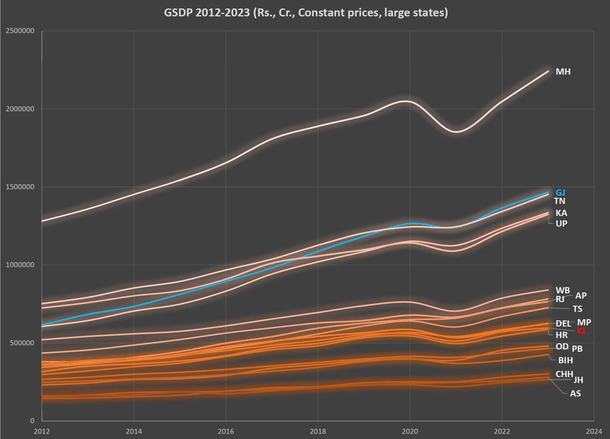
The list of laggards is a wide spectrum, ranging from a still-overwhelmingly rural Bihar, through Kerala which has the best Human Development Indices (HDI) in the country, to what was once India’s richest state — The Punjab.
A comparative chart of five states brings this disparity out clearly. On the one hand, we see that Gujarat is charting a unique and inspiring trajectory, while Uttar Pradesh, our largest state by far and a notorious laggard until 2016, finally appears to be on the move.
Sadly, on the other hand, though, that much-vaunted ‘Kerala Model’ appears to have degenerated into a fig leaf for an impending fiscal cataclysm, ‘Udta Punjab’ has been failing to gain altitude for over a decade now, and Bihar remains ‘that’ place which is still bypassed by real progress.
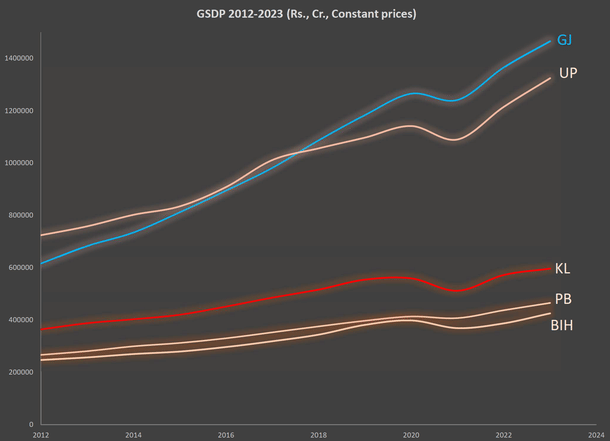
The next comparison involved a rigorous analysis of the value added to a state’s Gross State Domestic Product (GSDP) by agriculture, manufacturing, and services, for the financial year 2022-23 (2023-24 could not be used because the data set is incomplete since figures for many states have yet to be published).
In order to neatly project both absolute and relative values of the large states into one graphic, the following methodology was adopted: three dimensionless bubble cross plots were generated for agriculture, manufacturing, and services, in which, per capita value addition was plotted on the Y-axis against state population size on the X-axis.
The size of the value added by each state’s economy to each of the three sectors was then overlain as bubbles of varying sizes; the larger the bubble, the greater the sector’s contribution to GSDP. Thus, if a state with a large population has a smaller bubble than one with a much smaller population, obviously, the former is underperforming.
First, agriculture:
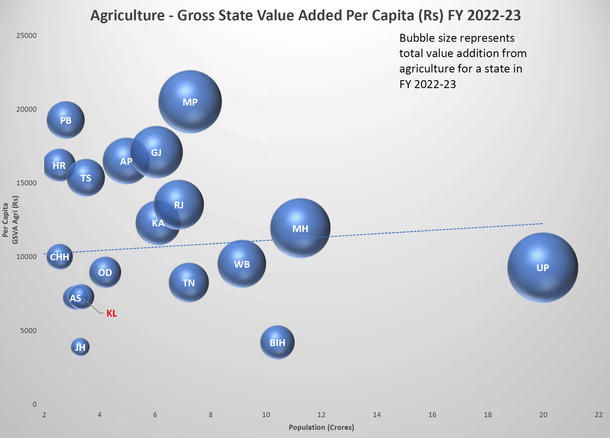
To much surprise, Madhya Pradesh tops the list. Or maybe not so surprising, because the forceful, sustained, focused manner in which the Bharatiya Janata Party (BJP) has brought a near-revolutionary transformation to the agriculture sector in the state over the past two decades, is probably why it keeps getting re-elected there.
While it is no surprise that big granaries of the subcontinent like The Punjab, Haryana, Telangana, and Andhra Pradesh cluster well above the dotted India average line, it is once again a reflection of sustained government policy (again, by the BJP) that has forced two very drought-prone arid states like Gujarat and Rajasthan to rise markedly above the national average. Encouragingly, Odisha has nearly doubled its value added from agriculture in the past six years.
In stark contrast, the sustained pursuit of a socialist ‘Kerala model,’ in a state which is so heavily blessed with both bountiful rainfall and rich, fertile soil, has resulted in shocking stagnation of the agriculture sector and deplorable production levels. Jharkhand has actually experienced a shrinkage of the agriculture sector in value-added terms, plus strong fluctuations, from 2017 to now, for reasons which are not immediately apparent.
Bihar, the third most populous state of the union, remains at the bottom of the list for a host of legacy structural reasons that no government has been able to overcome yet. This is a crying shame.
Second, manufacturing:
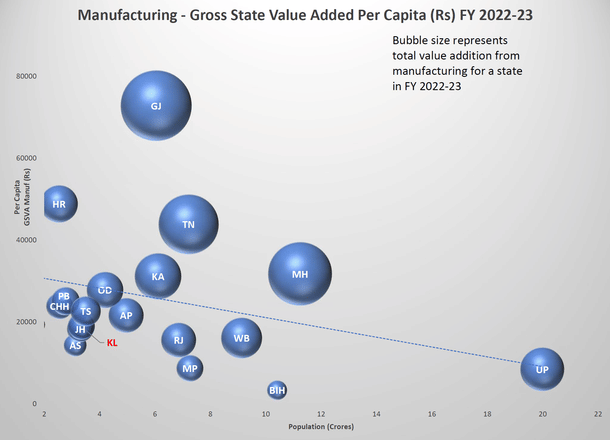
Gujarat has now entered a league of its own in both absolute and relative terms. It has firmly zoomed past the other three traditional industrial powerhouses, Maharashtra, Tamil Nadu, and Karnataka, to become the number one manufacturing state in the country.
The massing of industrial clusters in Haryana and Delhi means that both states now hold their own, but in absolute terms, they are still well behind the Big Four. The fastest growth by manufacturing value since 2017 has been Andhra Pradesh. It has doubled in this period, and if these trends keep up over the next decade, the state could claim its seat at the high table of industry.
On the other hand, value addition from manufacturing has unfortunately stagnated in Telangana, a state which had shown great signs of becoming a manufacturing giant under Chandra Babu Naidu earlier this century (prior to bifurcation). It appears that the momentum has unfortunately ebbed. This is possibly one of the primary reasons why voters there have rejected the K Chandrashekhar Rao government twice (at both the state and national levels) in the past year.
On the socialist side of the fence, Kerala, a state which had modern steel mills, textile mills, and factories even before independence, remains a manufacturing minnow with the blessings of its patron saint, Karl Marx.
Third, services:

It is no surprise that Karnataka tops the list in per capita terms since it is the coding capital of the country. Similarly, it is no surprise that Maharashtra is number one in absolute terms since Mumbai is the nation’s financial capital.
Kerala may make a surprise appearance near the top, but do not be misled; while the state has an extremely evolved and flourishing service sector, the consumption comes not from earnings or profits generated by economic activity within the state, but from foreign remittances. This is the sole reason why the state has not descended into utter financial chaos… yet.
Decades of communism, followed by a decade of ‘welfarism’ under Mamta Banerjee, means that West Bengal remains the largest, most consistent underperformer across metrics. Punjab is now firmly below the national average. And once again, Bihar is nowhere; its value addition in both absolute and relative terms is near the bottom of the list.
To sum up, only four states show robust, balanced economic growth across the three main sectors — agriculture, manufacturing, and services: Maharashtra, Gujarat, Tamil Nadu, and Karnataka.
These states will remain the prime movers of our economy for a good while to come until Uttar Pradesh, Andhra Pradesh, Rajasthan, Madhya Pradesh and Telangana come into their own (they will, albeit at an agonisingly gradual pace). Additionally, an industrial revival is wrought in Punjab, West Bengal, and Bihar.
Venu Gopal Narayanan is an independent upstream petroleum consultant who focuses on energy, geopolitics, current affairs and electoral arithmetic. He tweets at @ideorogue.





